| |
Pacific Coast Shark Attack Statistics
The total number (108) of authenticated cases of shark attack reported
from the Pacific Coast of North America during the Twentieth Century
is insufficient to determine the probability, or odds, of encountering
a shark when entering these waters. During the first half of the Twentieth
Century only one authenticated unprovoked shark attack was reported
from the Pacific Coast, with the remaining 107 cases occurring during
the last half of this 100-year period. The total number of reported
shark attacks speaks volumes about the rarity of these events, when
compared to the almost astronomical number of potential victims that
entered the waters of the Pacific Coast during the Twentieth Century.
Due to the extremely low number of attacks being analyzed in this
study, the ramifications — if any — of the data presented
here are considered with a healthy measure of caution and common sense.
Attack Documentation Sources
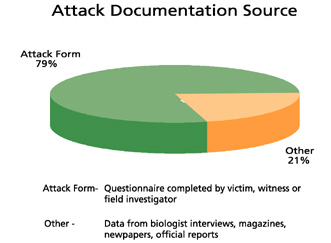 In
his analysis of the ISAF, Baldridge noted, “It was sobering
to find that 89.9% of the files on human shark attack held in the
ISAF, accounts of what happened were based primarily upon information
supplied by persons who were neither the objects of the attacks nor
were they even there at the time to actually see what happened. To
be completely realistic, therefore, it must be conceded that the ISAF
is made up largely of hearsay evidence, mostly documented long after
the event happened.” In
his analysis of the ISAF, Baldridge noted, “It was sobering
to find that 89.9% of the files on human shark attack held in the
ISAF, accounts of what happened were based primarily upon information
supplied by persons who were neither the objects of the attacks nor
were they even there at the time to actually see what happened. To
be completely realistic, therefore, it must be conceded that the ISAF
is made up largely of hearsay evidence, mostly documented long after
the event happened.”
In contrast to the ISAF analysis, primary data for 84 (78%) of the
108 cases included in this study were obtained from Shark Research
Committee questionnaires that were completed either by the victim,
rescuers, witnesses, or qualified field investigators. The remaining
24 (22%) cases derived their data from either ISAF case histories,
published and unpublished accounts by research biologists, medical
records, local or federal government agency reports, or newspaper
and/or magazine articles.
Thus, unlike the ISAF data, the vast majority of information about
shark attacks included in the present study was supplied by people
who were actually there. Due to the sustained effort to collect this
information, it is hoped that the resulting data are at least somewhat
more accurate than the “largely hearsay” data
reported by Baldridge.
Attacks Related to Age of Victim
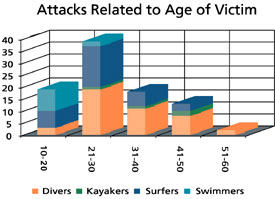 The
median age of Pacific Coast residents was not available for the present
study. However, the average age for all victims included in this study
is 29 years. Victim age was available for 91 (84%) of the 108 cases
considered in this study. The average age (in years) of each victim
group breaks down as follows: swimmers 18, surfers 27, divers 33,
and kayakers 37. Note that the average age of victims in each group
reflects the average age of participants in each group - there are
plenty of teenagers who splash about at the beach but very few 50-year-old
surfers, a fact that is reflected by the data. The
median age of Pacific Coast residents was not available for the present
study. However, the average age for all victims included in this study
is 29 years. Victim age was available for 91 (84%) of the 108 cases
considered in this study. The average age (in years) of each victim
group breaks down as follows: swimmers 18, surfers 27, divers 33,
and kayakers 37. Note that the average age of victims in each group
reflects the average age of participants in each group - there are
plenty of teenagers who splash about at the beach but very few 50-year-old
surfers, a fact that is reflected by the data.
Attacks Related To Victim Groups
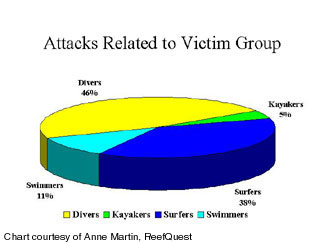 Because of the divergent activities required of surfing, diving, kayaking,
and swimming, it was necessary to define the victim groups into which
each of the 108 authenticated shark attacks reported in this study
would be placed. Definitions of the water activities required for
inclusion in the swimmer victim group were: swimming and body surfing
(when the participant did not use a board). Those in the surfer victim
group included: surfboarders, body boarders, boogie boarders, paddle
boarders, and wind surfers. The diver victim group included: commercial
(hookah), scuba, and free diving. There was no authenticated case
of a shark attack against a hard-hat diver along the Pacific Coast
during the entire Twentieth Century. The kayaker victim group is composed
of those utilizing a kayak or similar oceangoing vessel. To this writing,
Jet Skis had not been struck by, or encountered, a White Shark. However,
a review of the above ocean sport activities would suggest that Jet
Skis will most likely become the next victim group sometime, early
on, in the Twenty-First Century. The distribution of the 108 authenticated
unprovoked shark attacks from the Pacific Coast among these victim
groups is: divers, 50 (46%); surfers, 41 (38%); swimmers, 12 (11%);
and kayakers, 5 (5%).
Because of the divergent activities required of surfing, diving, kayaking,
and swimming, it was necessary to define the victim groups into which
each of the 108 authenticated shark attacks reported in this study
would be placed. Definitions of the water activities required for
inclusion in the swimmer victim group were: swimming and body surfing
(when the participant did not use a board). Those in the surfer victim
group included: surfboarders, body boarders, boogie boarders, paddle
boarders, and wind surfers. The diver victim group included: commercial
(hookah), scuba, and free diving. There was no authenticated case
of a shark attack against a hard-hat diver along the Pacific Coast
during the entire Twentieth Century. The kayaker victim group is composed
of those utilizing a kayak or similar oceangoing vessel. To this writing,
Jet Skis had not been struck by, or encountered, a White Shark. However,
a review of the above ocean sport activities would suggest that Jet
Skis will most likely become the next victim group sometime, early
on, in the Twenty-First Century. The distribution of the 108 authenticated
unprovoked shark attacks from the Pacific Coast among these victim
groups is: divers, 50 (46%); surfers, 41 (38%); swimmers, 12 (11%);
and kayakers, 5 (5%).
Attacks Related To Month
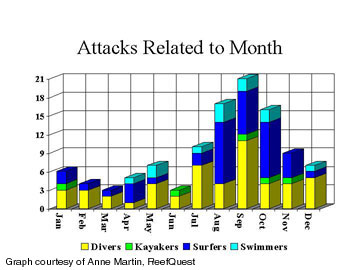 Along
the Pacific Coast of North America, shark attacks on humans occurred
in every month of the year, with a dramatic peak during August, September
and October. The fewest attacks reported for a month were three each
for March and June. There were four shark attacks reported in February
and five for April. January had six confirmed attacks, with May and
December reporting seven cases each. There were nine cases authenticated
for November, with 10 incidents occurring during July. These nine
months accounted for 54 (50%) of the 108 confirmed shark attacks from
the Pacific Coast. The remaining 54 (50%) shark-attack cases were:
16 reported in October, 17 in August, and 21 in September. Along
the Pacific Coast of North America, shark attacks on humans occurred
in every month of the year, with a dramatic peak during August, September
and October. The fewest attacks reported for a month were three each
for March and June. There were four shark attacks reported in February
and five for April. January had six confirmed attacks, with May and
December reporting seven cases each. There were nine cases authenticated
for November, with 10 incidents occurring during July. These nine
months accounted for 54 (50%) of the 108 confirmed shark attacks from
the Pacific Coast. The remaining 54 (50%) shark-attack cases were:
16 reported in October, 17 in August, and 21 in September.
During these three "peak months," 19 divers and 26 surfers
were attacked, representing 38% and 63% of the total number of attacks
for their respective groups. Current data on diving usage along the
Pacific Coast were not available, however, diving is most pleasant
from midsummer until late fall, after which winter storms severely
reduce underwater visibility due to plankton blooms and increased
turbidity from river run-off. At such times, only the most ardent
sport divers and commercial divers are found in the water. In the
case of surfers they prefer those areas in and around river mouths
because of their gently sloping, sandy bottoms, which generate the
large, predictable waves that produce the longest and most satisfying
rides. There appears to be a strong correlation between the time of
year that anadromous fishes (such as Pacific salmon and Steelhead,
of the family Salmonidae) congregate at river mouths in preparation
for their annual spawning runs and the incidence of White Shark attacks
on surfers, divers, kayakers, and swimmers at or near these locations.
Attacks Related To Time of Day
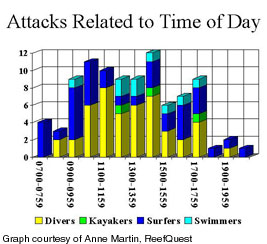 Pacific
Coast shark attacks occurred during all daylight hours. They were
relatively constant between 0900 and 1800 hours and did not occur between
2015 and 0719 hours. The hours during which no attacks were recorded
correspond roughly to the period between sunset and daybreak, with
the early morning and late evening extremes involving surfers. Most
swimmers heed traditional advice and do not enter the ocean before
dawn or after sunset. Unlike divers and kayakers, surfers can engage
in their sport within minutes of arriving at the beach. Further, unlike
divers, surfers are not dependent on ambient light levels to engage
in their sport, relying on kinesthetic cues (the feel of their boards'
reactions) rather than visual ones. Therefore, surfers can extend
their use of the ocean both earlier and later than can swimmers or
divers. Pacific
Coast shark attacks occurred during all daylight hours. They were
relatively constant between 0900 and 1800 hours and did not occur between
2015 and 0719 hours. The hours during which no attacks were recorded
correspond roughly to the period between sunset and daybreak, with
the early morning and late evening extremes involving surfers. Most
swimmers heed traditional advice and do not enter the ocean before
dawn or after sunset. Unlike divers and kayakers, surfers can engage
in their sport within minutes of arriving at the beach. Further, unlike
divers, surfers are not dependent on ambient light levels to engage
in their sport, relying on kinesthetic cues (the feel of their boards'
reactions) rather than visual ones. Therefore, surfers can extend
their use of the ocean both earlier and later than can swimmers or
divers.
With only five cases involving kayakers, it is impossible to draw
any firm conclusions about the temporal patterns of ocean use by this
victim group. However, due to the amount of water covered (frequently
20 kilometers or more), kayakers present themselves over a wider area
than do surfers — who typically stay within the area chosen —
or sport divers, whose range is limited by their air supply. Like
surfers, kayakers are not greatly affected by ocean water temperature
and thus can paddle for extended periods. With the increasing popularity
of ocean kayaking clubs and the growing trend toward "moonlight" excursions
— reminiscent of horseback riding under the stars — an attack
by a White Shark against a kayak after sunset would seem to be only
a matter of time.
In any case, temporal patterns of shark attacks along the Pacific
Coast during the Twentieth Century probably reflect the strong diurnal
bias of human activity rather than that of sharks.
Attacks Related to Water Depth
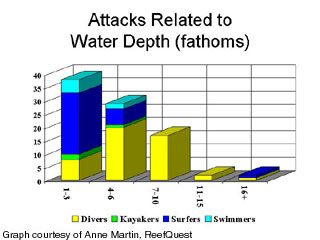 Of
the 108 authenticated cases of shark attack occurring along the Pacific
Coast during the Twentieth Century, data on water depth were available
for 88 (82%) cases. Of these 88 cases, 30 (34%) were directed at surfers,
while 48 (55%) were against divers. The predominance of depth data
reported by divers reflects the fact that accurate depth gauges are
a standard part of diving equipment. Of the 30 reported attacks against
surfers, 23 (77%) occurred where the water depth was 1 to 3 fm. Of
the 48 reported attacks on divers, 37 (77%) occurred where the water
depth was between 4 and 10 fm, with 20 of the 37 (54%) occurring where
the depth was 4 to 6 fm. Attacks against surfers occurred over relatively
shallow, near-shore waters that are conducive to surf riding. Attacks
against divers occurred in or over somewhat deeper water, but within
the limits of diver safety and comfort. Therefore, once again, these
data probably reflect the demands of the chosen ocean sport and/or
human preferences for ocean usage, rather than the depth preferences
of attacking sharks. Of
the 108 authenticated cases of shark attack occurring along the Pacific
Coast during the Twentieth Century, data on water depth were available
for 88 (82%) cases. Of these 88 cases, 30 (34%) were directed at surfers,
while 48 (55%) were against divers. The predominance of depth data
reported by divers reflects the fact that accurate depth gauges are
a standard part of diving equipment. Of the 30 reported attacks against
surfers, 23 (77%) occurred where the water depth was 1 to 3 fm. Of
the 48 reported attacks on divers, 37 (77%) occurred where the water
depth was between 4 and 10 fm, with 20 of the 37 (54%) occurring where
the depth was 4 to 6 fm. Attacks against surfers occurred over relatively
shallow, near-shore waters that are conducive to surf riding. Attacks
against divers occurred in or over somewhat deeper water, but within
the limits of diver safety and comfort. Therefore, once again, these
data probably reflect the demands of the chosen ocean sport and/or
human preferences for ocean usage, rather than the depth preferences
of attacking sharks.
Attacks Related to Collecting of Marine Organisms
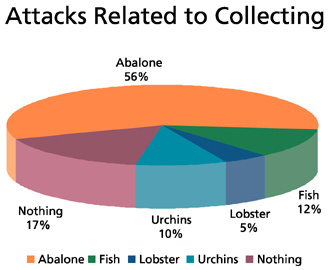 In
the ISAF analysis Baldridge determined that "of 103 free
divers where judgement was possible, 80% were engaged in spearfishing.
It was possible to conclude in 72 cases that 51% of the free-diver
victims had captive fish in their possession at the times that they
were attacked. SCUBA divers showed a lower incidence of spearfishing;
53% of 19 cases, with almost all of them (50% of 18 cases) possessing
captured fish. These data appeared to severely indict spearfishing
as a provocative act leading possibly to shark attack. Logic supports
this conclusion. However, it cannot be statistically validated in
the absence of corresponding data on diver non-victims." In
the ISAF analysis Baldridge determined that "of 103 free
divers where judgement was possible, 80% were engaged in spearfishing.
It was possible to conclude in 72 cases that 51% of the free-diver
victims had captive fish in their possession at the times that they
were attacked. SCUBA divers showed a lower incidence of spearfishing;
53% of 19 cases, with almost all of them (50% of 18 cases) possessing
captured fish. These data appeared to severely indict spearfishing
as a provocative act leading possibly to shark attack. Logic supports
this conclusion. However, it cannot be statistically validated in
the absence of corresponding data on diver non-victims."
Of the 108 cases included in the present study, 50 (47%) were hunting
or collecting marine organisms. All 50 of them belong to the diver
victim group, of which 24 (56%) were collecting abalone, 12 (29%)
were spearfishing, four (10%) were commercial urchin divers, and two
(5%) were hunting lobster. It is intriguing that no divers whose efforts
were dedicated to underwater photography along the Pacific Coast were
bitten by sharks during the entire Twentieth Century. This may be
because underwater photographers are generally fine and observant
marine naturalists, keenly aware of what is happening in the environment
around them. In contrast, divers concentrating on hunting and capturing
marine organisms often focus on their purpose to the exclusion of
all else. This degree of concentration may render diving hunters vulnerable
to attack by sharks.
Species of Attacking Shark
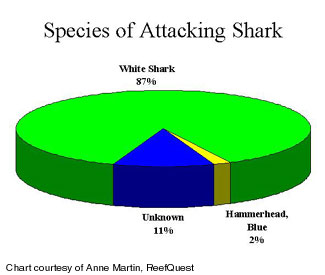 In
H. David Baldridge's 1973 published analysis of the International
Shark Attack File, he determined the following: "At least some
level of identification of the attacker was possible in 267 cases.
As popular belief would have it, the great white shark (Carcharodon
carcharias) was cited most often, with 32 [12%] known attacks
to its discredit." This global ISAF result pales in comparison
to that of this regional study of attacks from the Pacific Coast of
North America.. Of the 108 authenticated cases of shark attack reported
during the Twentieth Century, 12 (11%) were unidentified, one (1%)
was attributable to the Blue Shark, and one (1%) to the Common Hammerhead.
In the remaining 94 cases (87%) the White Shark was either positively
identified or highly suspect as the species responsible for the attack.
Distribution of these 94 cases among victim groups is as follows:
six swimmers (7%), 45 divers (48%), 39 surfers (41%) and four kayakers
(4%). Therefore, in the unlikely event that you are attacked by a
shark off the Pacific Coast of North America, the odds are 9 to 1
that it will be a White Shark. With the close of the Twentieth Century,
it is estimated that more than 60% of all recorded White Shark attacks
worldwide had occurred off the Pacific Coast of North America. In
H. David Baldridge's 1973 published analysis of the International
Shark Attack File, he determined the following: "At least some
level of identification of the attacker was possible in 267 cases.
As popular belief would have it, the great white shark (Carcharodon
carcharias) was cited most often, with 32 [12%] known attacks
to its discredit." This global ISAF result pales in comparison
to that of this regional study of attacks from the Pacific Coast of
North America.. Of the 108 authenticated cases of shark attack reported
during the Twentieth Century, 12 (11%) were unidentified, one (1%)
was attributable to the Blue Shark, and one (1%) to the Common Hammerhead.
In the remaining 94 cases (87%) the White Shark was either positively
identified or highly suspect as the species responsible for the attack.
Distribution of these 94 cases among victim groups is as follows:
six swimmers (7%), 45 divers (48%), 39 surfers (41%) and four kayakers
(4%). Therefore, in the unlikely event that you are attacked by a
shark off the Pacific Coast of North America, the odds are 9 to 1
that it will be a White Shark. With the close of the Twentieth Century,
it is estimated that more than 60% of all recorded White Shark attacks
worldwide had occurred off the Pacific Coast of North America.
|

 In
his analysis of the ISAF, Baldridge noted, “It was sobering
to find that 89.9% of the files on human shark attack held in the
ISAF, accounts of what happened were based primarily upon information
supplied by persons who were neither the objects of the attacks nor
were they even there at the time to actually see what happened. To
be completely realistic, therefore, it must be conceded that the ISAF
is made up largely of hearsay evidence, mostly documented long after
the event happened.”
In
his analysis of the ISAF, Baldridge noted, “It was sobering
to find that 89.9% of the files on human shark attack held in the
ISAF, accounts of what happened were based primarily upon information
supplied by persons who were neither the objects of the attacks nor
were they even there at the time to actually see what happened. To
be completely realistic, therefore, it must be conceded that the ISAF
is made up largely of hearsay evidence, mostly documented long after
the event happened.” The
median age of Pacific Coast residents was not available for the present
study. However, the average age for all victims included in this study
is 29 years. Victim age was available for 91 (84%) of the 108 cases
considered in this study. The average age (in years) of each victim
group breaks down as follows: swimmers 18, surfers 27, divers 33,
and kayakers 37. Note that the average age of victims in each group
reflects the average age of participants in each group - there are
plenty of teenagers who splash about at the beach but very few 50-year-old
surfers, a fact that is reflected by the data.
The
median age of Pacific Coast residents was not available for the present
study. However, the average age for all victims included in this study
is 29 years. Victim age was available for 91 (84%) of the 108 cases
considered in this study. The average age (in years) of each victim
group breaks down as follows: swimmers 18, surfers 27, divers 33,
and kayakers 37. Note that the average age of victims in each group
reflects the average age of participants in each group - there are
plenty of teenagers who splash about at the beach but very few 50-year-old
surfers, a fact that is reflected by the data. Because of the divergent activities required of surfing, diving, kayaking,
and swimming, it was necessary to define the victim groups into which
each of the 108 authenticated shark attacks reported in this study
would be placed. Definitions of the water activities required for
inclusion in the swimmer victim group were: swimming and body surfing
(when the participant did not use a board). Those in the surfer victim
group included: surfboarders, body boarders, boogie boarders, paddle
boarders, and wind surfers. The diver victim group included: commercial
(hookah), scuba, and free diving. There was no authenticated case
of a shark attack against a hard-hat diver along the Pacific Coast
during the entire Twentieth Century. The kayaker victim group is composed
of those utilizing a kayak or similar oceangoing vessel. To this writing,
Jet Skis had not been struck by, or encountered, a White Shark. However,
a review of the above ocean sport activities would suggest that Jet
Skis will most likely become the next victim group sometime, early
on, in the Twenty-First Century. The distribution of the 108 authenticated
unprovoked shark attacks from the Pacific Coast among these victim
groups is: divers, 50 (46%); surfers, 41 (38%); swimmers, 12 (11%);
and kayakers, 5 (5%).
Because of the divergent activities required of surfing, diving, kayaking,
and swimming, it was necessary to define the victim groups into which
each of the 108 authenticated shark attacks reported in this study
would be placed. Definitions of the water activities required for
inclusion in the swimmer victim group were: swimming and body surfing
(when the participant did not use a board). Those in the surfer victim
group included: surfboarders, body boarders, boogie boarders, paddle
boarders, and wind surfers. The diver victim group included: commercial
(hookah), scuba, and free diving. There was no authenticated case
of a shark attack against a hard-hat diver along the Pacific Coast
during the entire Twentieth Century. The kayaker victim group is composed
of those utilizing a kayak or similar oceangoing vessel. To this writing,
Jet Skis had not been struck by, or encountered, a White Shark. However,
a review of the above ocean sport activities would suggest that Jet
Skis will most likely become the next victim group sometime, early
on, in the Twenty-First Century. The distribution of the 108 authenticated
unprovoked shark attacks from the Pacific Coast among these victim
groups is: divers, 50 (46%); surfers, 41 (38%); swimmers, 12 (11%);
and kayakers, 5 (5%).  Along
the Pacific Coast of North America, shark attacks on humans occurred
in every month of the year, with a dramatic peak during August, September
and October. The fewest attacks reported for a month were three each
for March and June. There were four shark attacks reported in February
and five for April. January had six confirmed attacks, with May and
December reporting seven cases each. There were nine cases authenticated
for November, with 10 incidents occurring during July. These nine
months accounted for 54 (50%) of the 108 confirmed shark attacks from
the Pacific Coast. The remaining 54 (50%) shark-attack cases were:
16 reported in October, 17 in August, and 21 in September.
Along
the Pacific Coast of North America, shark attacks on humans occurred
in every month of the year, with a dramatic peak during August, September
and October. The fewest attacks reported for a month were three each
for March and June. There were four shark attacks reported in February
and five for April. January had six confirmed attacks, with May and
December reporting seven cases each. There were nine cases authenticated
for November, with 10 incidents occurring during July. These nine
months accounted for 54 (50%) of the 108 confirmed shark attacks from
the Pacific Coast. The remaining 54 (50%) shark-attack cases were:
16 reported in October, 17 in August, and 21 in September. Pacific
Coast shark attacks occurred during all daylight hours. They were
relatively constant between 0900 and 1800 hours and did not occur between
2015 and 0719 hours. The hours during which no attacks were recorded
correspond roughly to the period between sunset and daybreak, with
the early morning and late evening extremes involving surfers. Most
swimmers heed traditional advice and do not enter the ocean before
dawn or after sunset. Unlike divers and kayakers, surfers can engage
in their sport within minutes of arriving at the beach. Further, unlike
divers, surfers are not dependent on ambient light levels to engage
in their sport, relying on kinesthetic cues (the feel of their boards'
reactions) rather than visual ones. Therefore, surfers can extend
their use of the ocean both earlier and later than can swimmers or
divers.
Pacific
Coast shark attacks occurred during all daylight hours. They were
relatively constant between 0900 and 1800 hours and did not occur between
2015 and 0719 hours. The hours during which no attacks were recorded
correspond roughly to the period between sunset and daybreak, with
the early morning and late evening extremes involving surfers. Most
swimmers heed traditional advice and do not enter the ocean before
dawn or after sunset. Unlike divers and kayakers, surfers can engage
in their sport within minutes of arriving at the beach. Further, unlike
divers, surfers are not dependent on ambient light levels to engage
in their sport, relying on kinesthetic cues (the feel of their boards'
reactions) rather than visual ones. Therefore, surfers can extend
their use of the ocean both earlier and later than can swimmers or
divers.  Of
the 108 authenticated cases of shark attack occurring along the Pacific
Coast during the Twentieth Century, data on water depth were available
for 88 (82%) cases. Of these 88 cases, 30 (34%) were directed at surfers,
while 48 (55%) were against divers. The predominance of depth data
reported by divers reflects the fact that accurate depth gauges are
a standard part of diving equipment. Of the 30 reported attacks against
surfers, 23 (77%) occurred where the water depth was 1 to 3 fm. Of
the 48 reported attacks on divers, 37 (77%) occurred where the water
depth was between 4 and 10 fm, with 20 of the 37 (54%) occurring where
the depth was 4 to 6 fm. Attacks against surfers occurred over relatively
shallow, near-shore waters that are conducive to surf riding. Attacks
against divers occurred in or over somewhat deeper water, but within
the limits of diver safety and comfort. Therefore, once again, these
data probably reflect the demands of the chosen ocean sport and/or
human preferences for ocean usage, rather than the depth preferences
of attacking sharks.
Of
the 108 authenticated cases of shark attack occurring along the Pacific
Coast during the Twentieth Century, data on water depth were available
for 88 (82%) cases. Of these 88 cases, 30 (34%) were directed at surfers,
while 48 (55%) were against divers. The predominance of depth data
reported by divers reflects the fact that accurate depth gauges are
a standard part of diving equipment. Of the 30 reported attacks against
surfers, 23 (77%) occurred where the water depth was 1 to 3 fm. Of
the 48 reported attacks on divers, 37 (77%) occurred where the water
depth was between 4 and 10 fm, with 20 of the 37 (54%) occurring where
the depth was 4 to 6 fm. Attacks against surfers occurred over relatively
shallow, near-shore waters that are conducive to surf riding. Attacks
against divers occurred in or over somewhat deeper water, but within
the limits of diver safety and comfort. Therefore, once again, these
data probably reflect the demands of the chosen ocean sport and/or
human preferences for ocean usage, rather than the depth preferences
of attacking sharks.  In
the ISAF analysis Baldridge determined that "of 103 free
divers where judgement was possible, 80% were engaged in spearfishing.
It was possible to conclude in 72 cases that 51% of the free-diver
victims had captive fish in their possession at the times that they
were attacked. SCUBA divers showed a lower incidence of spearfishing;
53% of 19 cases, with almost all of them (50% of 18 cases) possessing
captured fish. These data appeared to severely indict spearfishing
as a provocative act leading possibly to shark attack. Logic supports
this conclusion. However, it cannot be statistically validated in
the absence of corresponding data on diver non-victims."
In
the ISAF analysis Baldridge determined that "of 103 free
divers where judgement was possible, 80% were engaged in spearfishing.
It was possible to conclude in 72 cases that 51% of the free-diver
victims had captive fish in their possession at the times that they
were attacked. SCUBA divers showed a lower incidence of spearfishing;
53% of 19 cases, with almost all of them (50% of 18 cases) possessing
captured fish. These data appeared to severely indict spearfishing
as a provocative act leading possibly to shark attack. Logic supports
this conclusion. However, it cannot be statistically validated in
the absence of corresponding data on diver non-victims." In
H. David Baldridge's 1973 published analysis of the International
Shark Attack File, he determined the following: "At least some
level of identification of the attacker was possible in 267 cases.
As popular belief would have it, the great white shark (Carcharodon
carcharias) was cited most often, with 32 [12%] known attacks
to its discredit." This global ISAF result pales in comparison
to that of this regional study of attacks from the Pacific Coast of
North America.. Of the 108 authenticated cases of shark attack reported
during the Twentieth Century, 12 (11%) were unidentified, one (1%)
was attributable to the Blue Shark, and one (1%) to the Common Hammerhead.
In the remaining 94 cases (87%) the White Shark was either positively
identified or highly suspect as the species responsible for the attack.
Distribution of these 94 cases among victim groups is as follows:
six swimmers (7%), 45 divers (48%), 39 surfers (41%) and four kayakers
(4%). Therefore, in the unlikely event that you are attacked by a
shark off the Pacific Coast of North America, the odds are 9 to 1
that it will be a White Shark. With the close of the Twentieth Century,
it is estimated that more than 60% of all recorded White Shark attacks
worldwide had occurred off the Pacific Coast of North America.
In
H. David Baldridge's 1973 published analysis of the International
Shark Attack File, he determined the following: "At least some
level of identification of the attacker was possible in 267 cases.
As popular belief would have it, the great white shark (Carcharodon
carcharias) was cited most often, with 32 [12%] known attacks
to its discredit." This global ISAF result pales in comparison
to that of this regional study of attacks from the Pacific Coast of
North America.. Of the 108 authenticated cases of shark attack reported
during the Twentieth Century, 12 (11%) were unidentified, one (1%)
was attributable to the Blue Shark, and one (1%) to the Common Hammerhead.
In the remaining 94 cases (87%) the White Shark was either positively
identified or highly suspect as the species responsible for the attack.
Distribution of these 94 cases among victim groups is as follows:
six swimmers (7%), 45 divers (48%), 39 surfers (41%) and four kayakers
(4%). Therefore, in the unlikely event that you are attacked by a
shark off the Pacific Coast of North America, the odds are 9 to 1
that it will be a White Shark. With the close of the Twentieth Century,
it is estimated that more than 60% of all recorded White Shark attacks
worldwide had occurred off the Pacific Coast of North America.